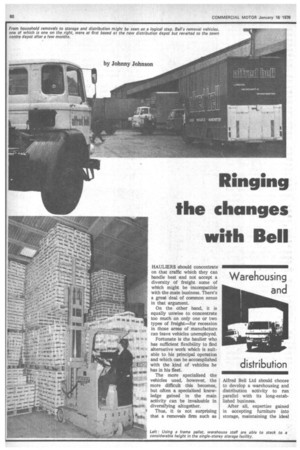Ringing the changes with Bell
Page 62

Page 63

If you've noticed an error in this article please click here to report it so we can fix it.
Warehousing and
HAULIERS should concentrate on that traffic which they can handle best and not accept a diversity of freight some of which might be incompatible with the main business. There's a great deal of common sense in that argument.
On the other hand, it is equally unwise to concentrate • too much on only one or two types of freight—for recession in those areas of manufacture can leave vehicles unemployed.
Fortunate is the haulier who has sufficient flexibility to find alternative work Which is suitable to his principal operation and which can be accomplished with the kind of vehicles he has in his fleet.
The more specialised the vehicles used, however, the more difficult this becomes, but often a specialised knowledge gained in the main activity can be invaluable in diversifying altogether.
Thus, it is not surprising that a removals firm such as Alfred Bell Ltd should choose to develop a warehousing and distribution activity to run parallel with its long-established business.
After all, expertise gained in 'accepting furniture into storage, maintaining the ideal conditions for its well-being while it is in the company's care and then delivering it to its owner when the period of custody is .finished has a great deal in common with conventional warehousing and distribution.
Though Bell had its beginnings in the North East—Newcastle upon Tyne, to be precise —it has built up a nationwide storage and distribution service over the past few years using • the knowledge of storage gained in its removals activity to construct eight purposebuilt depots. These are situated at London, Plymouth, Bristol, Birmingham, No tt ingham, Manchester, Newcastle and Glasgow.
They have all been constructed with a single floor and high roof to give easy access to vehicles and facilitate acceptance of freight and quick order picking.
All are provided with mechanical handling equipment including high-lift reach trucks and some are equipped with mechanised conveyor belts.
The range of products handled now includes foodstuffs and fragile goods such as television and other electrical appliances.
Night trunking is operated with an all-Leyland fleet of 32-ton artics and the distribution and collection is by a fleet of rigid boxvan vehicles of various sizes, though here again, all are Leyland manufacture.
Standardisation
This standardisation is considered a desirable aspect of vehicle reliability: Though the organisation is controlled from the main London office, I went to Newcastle upon Tyne where the company was originally formed to see the operation from there.
Though the company made an attempt, in the beginning of the distribution activity, to concentrate both removals and distribution from the new depot, this proved unfeasible and the removals side reverted to its former depot in the city centre.
Now, the specially designed depot at Kiningworth industrial estate is essentially devoted to storage and distribution.
Based on Newcastle, Bell has three 32-ton trunking vehicles and 12 collection and delivery vehicles, and both the trunking and c and d activities are quite conventional. The antic units drop loaded trailers and pick up others on the
Newsprint is taken into store and released to the order of the Newcastle Evening Chronicle. Boils released from the warehouse at 6am are being read by the citizens of Newcastle as newspapers the same evening.
return trip with freight for the Newcastle area. The smaller four-wheel rigids deliver in the morning and collect on the return journey later in the day.
Though the night trunk connects all the various depots in the Bell network, the main trunk from Newcastle is to Manchester.
Traffic for. Manchester area is lo:aded at the rear of the vehicle and is immediately unloaded on arrival for delivery.
Traffic at the front of the trailer is for sorting into onward transit from Manchester.
The tractor from Newcastle does not wait for this operation to be completed, however, but picks up a trailer with freight loaded for the Newcastle area and returns almost immediately to its Killingworth depot.
Here the traffic taken into store varies from foodstuffs to electrical equipment and rolls of newsprint. This last is a regular feature of the Newcastle depot day.
Using a fork-lift truck equipped with a large clamp in place of the conventional forks, the staff load newsprint each morning early and the load is on its way to the presses of the Evening Chronicle in Newcastle by 6am.
Thus, the newsprint that leaves the Killingworth depot early in the morning is being handled by the public in the form of newspapers by the early afternoon.
Other commodities such as toilet rolls and other toilet requisites are stored in caged pallets stacked four or five high in the warehouse until ordered for delivery by the customer.
Either the customer's own or Bell's system of stock control and order release can be adopted.












































































































